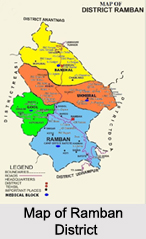 Ramban District is located on the lap of Pir Panjal Range in India and it offers stunning natural landscapes to the photographers who visit Jammu and Kashmir.
Ramban District is located on the lap of Pir Panjal Range in India and it offers stunning natural landscapes to the photographers who visit Jammu and Kashmir.
Location of Ramban District
Ramban District is one of the 22 districts in the state of Jammu and Kashmir. Ramban District is located in the lap of Pir Panjal Range of the Himalayan Mountain Range in India.
History of Ramban District
Ramban District was carved-out out of erstwhile Doda District keeping in view the backwardness, remoteness and aspiration of people of the area. Ramban District started functioning as independent unit on April 1, 2007. Ramban town is the district headquarters.
Administration of Ramban District
Ramban District in Jammu and Kashmir is divided into two tehsils: Ramban Tehsil and
Banihal Tehsil. Each tehsil has its Tehsildar, who is the administrative head. The district is further divided into four blocks: Ramban, Banihal, Gool and Ramsu. The administrative head of each block is the Block Development Officer (BDO). Each block consists of a number of panchayats. The district consisted of 116 census villages and 127 revenue villages in 2001. The total number of panchayat Halqas in the district is 124.
Geography of Ramban District
Ramban district is 1,156 metres (3,792 feet) above sea level. The boundary lines of Ramban district encompass hill station Patnitop as its southernmost point, Assar on its eastern edge, Gool to the west, and Banihal to the north. TerrinTerrain of district Ramban is tough and hilly. Ramban District shares its boundary with Reasi District, Udhampur District, Doda District, Anantnag District and Kulgam.
Climate of Ramban District
The climate of Ramban District varies according to altitude. The temperature rises as high as 42 degree Celsius in the low lying areas like Ramban town located in between steep Mountains on the banks of river Chenab and drops to sub zero in the high altitude areas like Dhagantop. Asthanmarg. Lalagundi, Budhan. The working season in most of the district is about eight months because of typical weather conditions in the district.
Demography of Ramban District
According to the 2011 census, Ramban district has a population of 283,313, roughly equal to the nation of Barbados. This gives it a ranking of 573rd in India out of a total of 640. The district has a population density of 213 inhabitants per square kilometre (550/sq mi). Its population growth rate over the decade 2001-2011 was 31.81%. Ramban has a sex ratio of 901 females for every 1000 males, and a literacy rate of 56.9%.
Culture of Ramban District
Kashmiri is the most widely spoken language in Ramban District. The other languages spoken here are Urdu language, Punjabi language, Dogri language, Poguli language, Sirazi language and Gojri language. Ramban district has Muslim majority, with Muslims constituting about 70% and Hindus constituting about 28% of the population.
Tourism in Ramban District
Pir Panjal Railway Tunnel is India`s Longest Railway Tunnel. It is 11.2 km long and will connect Banihal with Qazigund in Kashmir Valley. This tunnel is a part of Kashmir Railway. Baglihar Dam is being constructed by JP Industries at Chanderkote, about 8 km from Ramban. The potential of this project is 900 mW, and it will be completed in two phases of 450 mW each. These two are the major destinations.
Visiting Information
Ramban District is located midway between Jammu and Srinagar, in Srinagar District of Jammu and Kashmir along the Chenab river, on National Highway-44, originally National Highway 1A (India) approximately 150 km from Jammu and Srinagar.
Related Articles
Jammu and Kashmir
Districts of Jammu and Kashmir
Srinagar
Srinagar District



















